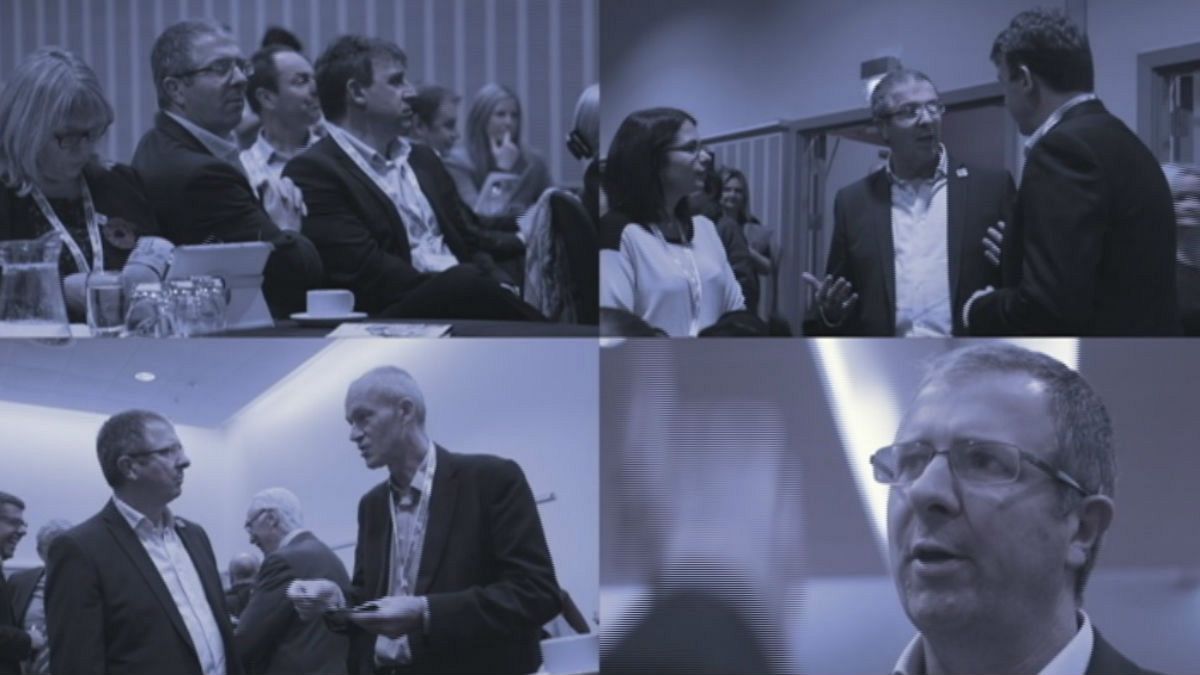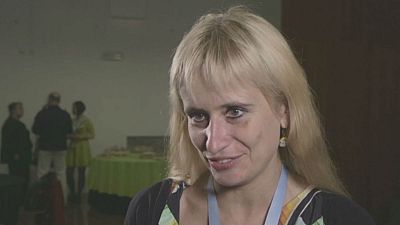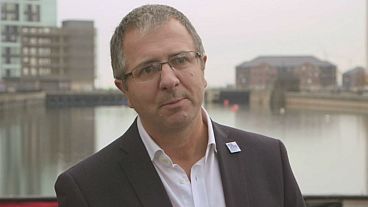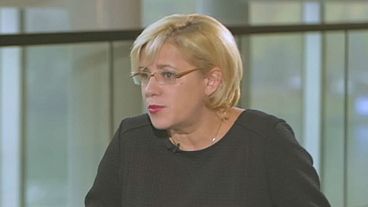In this episode of Real Economy, Maithreyi Seetharaman visits Strasbourg to look at how partnership and collaboration can breathe a new lease of life
In this episode of Real Economy, Maithreyi Seetharaman visits Strasbourg to look at how partnership and collaboration can breathe a new lease of life into the European economy.
On the show, the European Commissioner for Regional Policy explains how partnership can lead to tangible economic results. We also look at how a city like Liverpool, which has lagged a little behind, is using collaboration to regain some of its past glory. And we travel to Portugal to investigate how working together to adopt the best practices of successful past strategies can help to address some of the biggest issues facing Europe today.
More projects are needed using
EU_Regional</a> funds for integrating migrants says <a href="https://twitter.com/CorinaCretuEU">CorinaCretuEU in #realeconomyeuronews</a> episode on 10/11</p>— Maithreyi (maithreyi_s) 5 Novembre 2015
Together, a bit of elbow grease, some patient collaboration and well-directed investment can change the trajectory of Europe’s economy. Real Economy travels to the European Parliament to find out about how partnership at the EU and national level should trickle down to collaboration with local and city governments, civil society and businesses.
The aim is to give us all a sense of ownership about our investment and policy decisions. Here is a crash course on how it works:
- Europe’s countries first draw up plans for what they want to invest in, using the EU funds available
- To do that, they talk to representatives of different regions, cities, civil society and the private sector
- After this collaboration, countries then submit a Partnership Agreement (PA) on what is needed nationally to the European Commission, which adds more ideas
- The PA becomes a legal contract when it is approved and adopted
- The investment decisions, then become Operational Programmes (OP) as the funds come in
- These programmes are the actions that had priority for investment in the PA, to which everyone has contributed – and can be for and between countries, regions and cities with all stakeholders cooperating amongst themselves!
At the European Parliament, our representatives have been grabbing this opportunity of partnership at the macro level, which has led to lots of local collaborations to turn around lagging growth. Euronews reporter Sarah Chappell went to Liverpool to see how the idea works.
Liverpool on the comeback trail
The British port city of Liverpool was a commercial powerhouse throughout the 18th and 19th centuries. But by the mid 20th century, her docks and manufacturing industries were falling into decline – and the economy hit a wall during the UK recession of the 1970s.
“For decades, Liverpool thought her days of economic might were long confined to the past. But she’s been getting a face-lift and the change is more than skin-deep – with growth projects powered by lots of Liverpudlian elbow grease and plenty of collaboration,” reports euronews’ Sarah Chappell.
#Liverpool regeneration feature – on air from tomorrow
euronews</a> <a href="https://twitter.com/hashtag/realeconomy?src=hash">#realeconomy</a> - feat. <a href="https://twitter.com/LiverpoolLEP">LiverpoolLEPRevolverRetail</a> <a href="https://t.co/9Xm3GGVRjs">pic.twitter.com/9Xm3GGVRjs</a></p>— Sarah Chappell (SLeandaC) November 9, 2015
Massive regeneration over the last 25 years, driven by both private investment and public funding, has helped to build an economic infrastructure for business to thrive.
Close to 12 billion euros, via the European Regional Development Fund (ERDF) and the European Social Fund (ESF), is being allocated to the UK over the period 2014-2020 – with 220 million euros of that total destined for Liverpool City Region.
The Liverpool City Region Local Enterprise Partnership (LEP) is is the principal body for bringing together businesses, civic leaders and institutions to drive the economy forward.
Mark Basnett, Executive Director of the LEP, says: “You’ve got all the city leaders working together for a good number of years to work out what are our real strengths and competitive advantages? What are we great at nationally and internationally? Where have we got global capability? And our strategy is about building on that.”
The transformation of the port is at the heart the strategy that Basnett describes, and is expected to create tens of thousands of jobs for Liverpool and the surrounding area.
The Port of Liverpool has invested £300 million (approximately 430 million euros) in a state-of-the-art deepwater container terminal, capable of handling most of the largest vessels in the world. Once opened, Liverpool2 has the potential to transform UK supply chains and logistics.
In Liverpool’s revitalised city centre, initiatives to stimulate small and medium enterprise (SME) growth have given birth to a plethora of young businesses that do not want to be anywhere else.
Gary Carney is a co-founder of Revolver Retail and the REX concept shop, a venture he describes as an ‘independent department store.’
REX gives small local retailers, many of them sole traders who previously worked from home or at seasonal markets, an opportunity to sell their goods from a permanent, city centre location. Because the space is shared, these retailers pay just a fraction of the cost of renting and managing a whole shop alone – and they are able to have access to prime high street retail space all year round.
Carney’s innovative firm got going with a start-up loan from the Merseyside Special Investment Fund, which is backed by local, national and European funding.
“The reaction that we’ve got has been very supportive. I think everyone sees the value in what we’re doing, and that is reflected in how quickly this store has filled up,” explains Carney, who plans to expand to other cities, but says the heart of his business will always remain in Liverpool.
Despite increasing productivity, a recent surge in private sector job growth, and the availability of business opportunities for entrepreneurs like Carney – the Liverpool City Region still remains home to some of the most deprived areas in the UK.
Mark Basnett of the LEP says reaching these areas of social exclusion and longterm unemployment is the major challenge facing Liverpool over the next 10 years. He believes, however, that the decades of work already done on turning the economy around have created the conditions to make this possible.
“You start by creating the right economic infrastructure, where there are jobs for people that have that aspiration. We now have to make sure we reach all parts of our society,” Basnett concludes.
Interview with European Commissioner for Regional Policy, Corina Cretu
Corina Cretu, European Commissioner for Regional Policy: “It (partnership) is about involving everybody – because we cannot decide from Brussels what the countries, the regions, member states need. I think it is very important to cooperate together because we are now in a year where all the projects and all the investments for the next seven years are designed and selected and implementing.”
Maithreyi Seetharaman, Euronews: “What is so different now than it was in the past?”
CC: “Many countries had a lot of problems since the beginning because it is really policy which is complicated. In the last year programming period I was very much afraid that member states not do absorption for the sake of absorption. If they have teachers and come together with business people, local authorities they could design what is the best for their region for the next 7-10 years.”
MS: “Do you think that some regions that have lagged behind are themselves to blame or have we just not paid enough attention to them?”
CC: “We have regions where we invest a lot but we don’t see any economic growth or in terms of jobs some results – in others we see results very clearly. There is not any European region, which does not benefit from European money – be it from the Netherlands, to Germany, to France. I was in Berlin, for instance, and I was so proud of how they deal with refugees, I was in a suburb and the regeneration of urban areas, also in Paris – so I very much to encourage all the member states to use our funds for these projects.”
MS: “Is there any example you would hold up saying yes, this is the way you should do a partnership? And are there any which make you say “don’t do that!?”
CC: “It is something that I would say to the member states to the regions, to the managing authorities – not to add new regulations – any how these regulations to have in place are complicated because you have to assure the control also of the money. And if you add on the National Level some other requirements – its not good! I don’t want to see anymore Small and Medium size enterprises that they give up because they find the process too complicated, too lengthy and too bureaucratic. People on the ground know best what is working, what is not necessary. So, I would like to invite all of them to come with their ideas, because next year we will start to think about how this Cohesion Policy will look like after 2020 and we have to learn from our lessons
MS: “It’s a lot of money we’re talking about – who regulates? How do you keep it honest?
CC: “First of all, We rely very much on national auditors but also we have our auditors from the European Commission. We have zero tolerance to fraud. And also I think its very important that we work with Transparency International and of course all the countries should agree.”
MS: “When you look at Partnership and the investors being pulled into the Juncker Plan, is there a potential conflict of interest down the line?”
CC: “No, no – this is not our money, the Cohesion money is not touched. If it is a big project and the money from the investment bank is not enough – we can think about the combination of funds. But it is not any conflict. On the contrary, it is working together hand in hand.”
Arrival Cities
When an idea or a strategy looks like a success, picking up on its best practices, sharing and translating it across cities, regions and even countries can potentially recreate that success in combating the toughest challenges facing the world today. Euronews’ Monica Pinna went to Portugal to find out how.
#realeconomy team in #lisbon filming #arrivalcities
URBACT</a> <a href="https://twitter.com/maithreyi_s">maithreyi_spic.twitter.com/C49a6EoavQ— Monica Pinna (@_MonicaPinna) 29 Octobre 2015
What do the cities of Messina, Riga, Roquetas de Mar, Thessaloniki, Vantaa and Amadora have in common?
They are all European ‘arrival cities’. As such, they are all facing a myriad of challenges posed by Europe’s ongoing migration crisis.
They have joined forces to develop solutions to their shared challenges.
How? By cooperating, which is at the heart of the European programme Urbact, enabling cities to share and improve urban policies. The first meeting takes place in the Portuguese city of Amadora.
There, the Mayor of Amadora, Carla Tavares explains: “Nobody knows everything, and I know what is going on allows us to share realities, create experiences and share new ways of approaching challenges that we face everyday.”
Urbact is an instrument of the Cohesion Policy, co-financed by the European Regional Development Fund (ERDF), the 28 member states, Norway and Switzerland. The total budget for 2014-2020 is 96.3 million euros.
Urbact’s Celine Ethuin says: “We finance these trans-national exchanges and research so that each city can have a local action plan.”
At a meeting to kickstart the Arrival Cities network, representatives are convinced that partnerships can succeed where other strategies have struggled.
Andreas Karadakis, Thessaloniki Financial Manager at the Arrival Cities Project, says: “Greece is not a final destination, but it’s just a transit country on their way to northern Europe”.
For Hannele Lautiola, Municipality Coordinator of the Arrival Cities Project, the impact of the situation is different: “Our city has the highest percentage of migrant background in Finland.”
Juan Francisco Iborra Rubio, Municipality Manager of the project, says: “These projects are really interesting because they allow us to anticipate something that can happen before it takes place.”
“We had about 3,000 asylum seekers per year. This year we have already 30,000,” said Lautiola.
Mobility, youth employment and green technologies are the areas where Urbact has collected the best results since 2006, the year the programme launched.
But the urgency of the migration crisis has pushed that issue to the top of the agenda.
Euronews’ Monica Pinna reports: “This year over half a million people have crossed the Mediterranean seeking protection in Europe. In only three months, from April to June, over 213,000 first time asylum seekers applied for protection in the EU. A situation that requires funds, policies and organisation.”
Reception Centre for Refugees
The Reception Centre for Refugees in Bobadela, on the outskirts of Lisbon, was created in 2006 for 42 people. It now hosts 76 refugees from more than 20 countries. Portugal is expecting more in November.
Cristina Farinha, director of the Bobadela Reception Centre, says: “We have 61 or 62 people we support outside the centre, whose accommodation we pay for. In total we are helping 276 people. All partnerships are important and we have to work on them because we cannot do everything by ourselves.”
It is estimated that around 70 percent of the EU population live in urban areas (of more than 5,000 inhabitants). They are key generators of national growth but they also face high risks of inequalities and exclusion. This is why cities are the main beneficiaries of Urbact.
Bonus links:
Partnership Agreements – by member state:
Europa
Key cities



